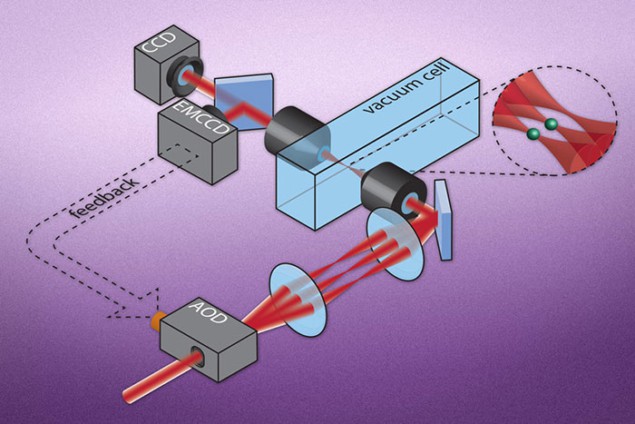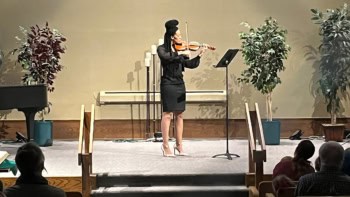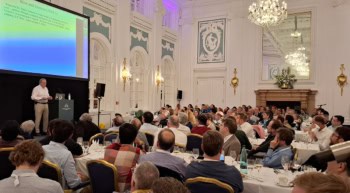
Quantum simulators that provide individual control over more than 50 interacting quantum bits (qubits) have been developed by two independent research groups in the US. The teams used their newfound computing power to discover new information about quantum phase transitions in materials. The simulators are a step towards a fully programmable quantum computer.
The quest to build quantum computers has captured the imagination of physicists worldwide. A complete set of quantum gates – the quantum equivalents of the logic gates necessary to build the processors in classical computers – has been demonstrated in several different qubit technologies including trapped ions. In principle, therefore, it should be possible to combine qubits to build a “universal quantum computer” that could be programmed to execute any quantum algorithm. However, the fidelity (reliability) of qubits and quantum gates remains too low to reliably carry out the long sequences of operations that would be necessary to create a practical quantum computer.
Quantum simulators are not universal, but instead are special-purpose machines containing arrays of quantum objects designed to simulate specific systems and provide insight into their behaviour. These are a bit like the forerunners of classical computers, which were designed to perform specific tasks such as addition and subtraction. Renato Renner of ETH Zurich in Switzerland explains that fidelity is less crucial in such machines: “In a calculation, one bit that is flipped makes the calculation completely wrong and useless,” he says, “Whereas in a simulation, a small deviation is tolerable because what I’m simulating is normally a system that is subject to noise.”
Hard to control
Several research groups have produced quantum simulators containing fewer than 20 individually controlled qubits. Other research groups have created systems with more than 100 qubits but have been unable to fully control and read them out individually. In the new research, the two teams have used different physical mediums to implement quantum simulations of magnetism in more than 50 individually controllable qubits.
Christopher Monroe and colleagues at the University of Maryland, College Park, used 53 electromagnetically trapped ions whose spins could be manipulated by a laser. This is a well-established quantum information protocol valued for the long coherence times of the qubits – where coherence time is a measure of how long quantum information will endure in a qubit before it is destroyed by external noise.
Meanwhile in Massachusetts, Mikhail Lukin and colleagues at Harvard University and the Massachusetts Institute of Technology (MIT) used 51 neutral atoms confined by sets of optical tweezers. A laser was used to excite an individual atom to a Rydberg state, which makes that atom interact strongly with other Rydberg atoms in the simulator. This is a much newer protocol developed independently by the Harvard–MIT group and researchers at l’Institut d’Optique in Paris in 2016. While the coherence times of the qubits are much shorter, interactions between qubits are much easier to control.
Phase transitions
Both groups used their systems to simulate magnetic phase transitions within ensembles of spins: Monroe’s group looked at how the spins switch from being aligned with each other to being aligned with an external field as the strength of the external field changes. “We could not predict ahead of time where’s the magic value at which the transition occurs,” says Monroe. “The problem was too hard for us to calculate on any classical computer.”
Lukin and colleagues looked at their system’s change from random ordering of the spins to various types of antiferromagnetic ordering as the distance between the atoms changed. The researchers discovered a new, stable, non-equilibrium quantum state: “If you want to discover it from scratch on a classical computer it’s very difficult to impossible,” says Lukin. “That’s why it hadn’t been discovered.”
Lukin says that, although their system can run only a limited set of algorithms, many parameters can still be programmed: “We explored several different types of quantum phase transitions,” he says, “where by programming the interactions we could change the type of phase transition, and we also explored how a system evolves if you go across a phase transition rapidly and create some non-equilibrium states of matter.” Picking up the analogy to the history of computing with a reference to the British computing genius who first conceived of a reprogrammable computer, he says, “We are now really entering the Alan Turing kind of era”.
Quantum power
Renner, who was not involved in the research, is excited: “If I remember what people said a few years ago about quantum computing, this would have been deemed completely unrealistic,” he says. “I’m really happy to see that these things are now experimentally proved.” He says that surmounting the figure of 50 individually controlled qubits is crucial: “The best classical algorithms can simulate something on the order of almost 50 qubits but then it stops…The fact that there are now 50 or a bit more than 50, really shows that the quantum technology is more powerful than the classical one.”
Christine Muschik of the University of Waterloo in Canada says that the simulators do not encode a complete set of quantum logical operations so she would consider them “textbook examples of not being quantum computers”. Nevertheless, she says, “they can still be incredibly useful”. Muschik says that researchers are working in parallel, with some focusing on absolute quantum control and others concentrating on increasing the numbers of bits. “In the future, probably, the two tracks will meet somewhere.”
The simulators are described in separate papers in Nature.


